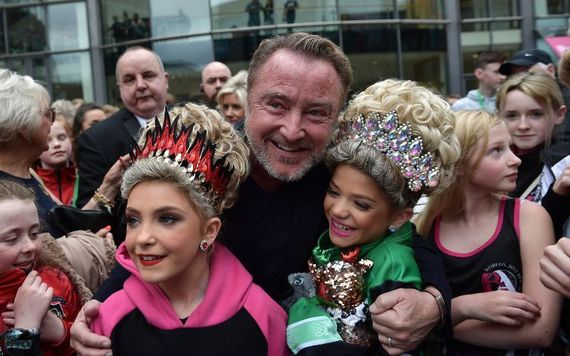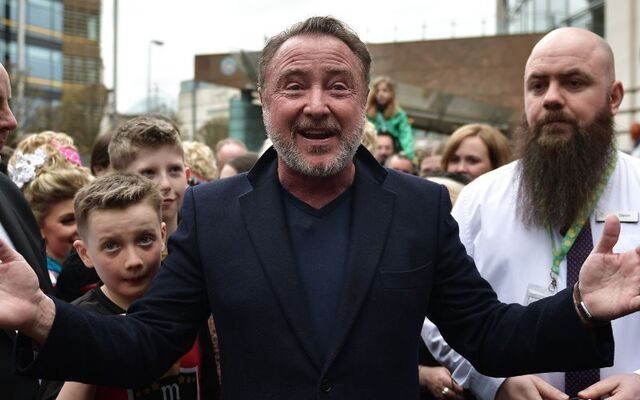Irish dance superstar Michael Flatley discussed how he helped redefine the traditional style of Irish dance in a new episode of the podcast Nicky Byrne HQ.
Flatley, who was born and raised in Chicago to parents from Co Carlow and Co Sligo, helped launch Irish dance into the mainstream when he starred in the Irish dance stage show "Riverdance" in 1994.
Flatley's spectacular entrance on the Eurovision stage - in a billowing satin blouse with his arms up and moving - became instantly iconic.
Flatley went on to create and star in his own Irish dance shows "Lord of the Dance," "Feet of Flames," and "Celtic Tiger."
The Irish dance shows famously reimagine the traditional styles of Irish dance where the dancer is typically expressionless with their arms straight down by their sides.

July 2, 1996: Michael Flatley in "Lord of the Dance" in Dublin. (RollingNews.ie)
On the new podcast episode, host Nicky Byrne asked about the non-traditional Irish dance style that Flatley has popularized.
Flatley, 66, recalled how he stepped into his first Irish dance class at 11 years old, only to be to told that he was "too late" to start as most children begin around five or six years old.
“Something inside of me, I don’t know why, I just got pissed off," Flatley told Byrne.
"I thought, ‘Well that’s not good enough that I can’t do it.’ I didn’t like being told no.”
Flatley said he went home and learned the steps from his friends who had been in classes longer than him.
“Then I caught up with the dance class so I could join the class that was my age,” Flatley said.
“The problem was, I was used to learning three, four, five steps a week from my buddies. So when I got to the dance class, they were learning a half a step a week. I was already going at speed.
“So in two or three weeks, I couldn’t stand it anymore.
“And I couldn’t understand … Irish people are so full of life and passion and love and fight and poetry and sadness and joy and just every kind of real passion, how can they dance with their arms at their sides with no facial expression?”
He continued: “I was never happy with that. And even by the time I was 15, I was teaching myself in my garage all these different moves and what I wanted to do and I was using my arms.
“But I quickly earned that when I came back to Ireland for the World Championships, you can’t do that.
“It was tough trying to acclimate. I got a special teacher to make sure my arms were perfect so I could win my World title.
“Once I did, it was the last time I ever held my arms at my sides.”
He continued: “I wanted to be a World Champion. There was no way around that. That was my goal, my focus was on it. I refused to lose.”
Recounting his World Championship competitions, Flatley said the first time he competed was “laughable,” but the second time, he came in fourth place, though he says he thought he "should have done a lot better.”
“Finally I struck gold in ‘75 and I won it," Flatley said. At 17 years old, he was the first-ever American to win a World Irish Dance title at Oireachtas Rince na Cruinne, CLRG's World Irish Dancing Championships.
"I knew right then, I was, in my mind, I was past it," Flatley said. "I saw it differently. I just saw it differently.”
Flatley explained how he’s now introduced a Freestyle competition at the World Irish Dancing Championships.
The competition, first hosted in 2023, is described as "a way to stimulate creativity and expression in Irish dance, without restrictions of arm movements, music, and theatrics."

Michael Flatley with dancers at the 2022 CLRG World Irish Dancing Championships in Belfast. (Getty Images)
“I want to give young people the chance to do that, I want them to have the opportunity to be prepared to go into a show right away," Flatley said.
“I have to take the dancers that come to me, even if they’re World Champions, and retrain them from this into how to be a show dancer.
“My job as a director, I take their raw talent and I just uncover it. I don’t need to manipulate it or force them into a box. Just uncover their talent.
“You couldn’t believe some of the girls, when they first come and they’re so focused and trained on exactly on how they have to dance, this Irish style. Once I take that straightjacket off, once I let them smile and be themselves and I’ll make a few jokes or tease them to get them to come out of themselves - the lights hit them and they come alive. They become the person they have inside, deep. They’re not being forced to hide it.
"Why should we hide it?”




Comments